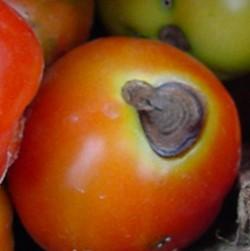Vegetable Diseases to Scout for: Early Blight and Septoria Leaf Spot
Kentucky vegetable growers, as well as gardeners, will likely be seeing early blight and Septoria leaf spot of tomato in their plantings at this time. As the most common diseases of tomato in Kentucky, homeowners or growers not on a preventative spray program always have at least some Septoria leaf spot and early blight pressure. Both early blight and Septoria leaf spot commonly occur in the field under wet, humid conditions. These diseases may also occur in greenhouses or high tunnels, particularly near side walls or when plants are grown in natural soil without plastic mulch. Prevention, early identification, and management will help reduce plant losses.
Here are the symptoms to look for, preventative tactics, and brief suggestions on how to treat crops once disease is confirmed.
Early Blight
Cause and Disease Development
Early blight is caused by the fungal pathogens Alternaria solani and A. tomatephila. These pathogens overwinter in plant debris from the previous season, or sometimes in association with solanaceous weeds. Spores are initially splashed onto the lowest leaves, where symptoms first become apparent, but frequent rain or overhead watering can spread spores throughout plants. Leaves, stems, and fruit may become infected at any stage of the growing season, but are most common on aging plant tissue. Early blight is favored by moderate temperatures, high humidity, and frequent rainfall. Once established, the disease can spread rapidly in dense plantings. Most potatoes are also very susceptible to early blight, and symptoms, preventative tactics, and management are similar to tomato.
Symptoms
Early blight appears as dark-brown lesions with concentric ring patterns developing on leaves or stems, sometimes with chlorotic (yellow) halo around lesions. Older leaves are usually affected first, with the disease spreading up the plant to affect newer growth. Lesions enlarge and may coalesce to result in blight (rapid dieback). Affected fruit develop dark-brown lesions with concentric ring patterns, typically at the attachment end.

Early blight results in the development of dark-brown lesions with a concentric ring or bulls-eye pattern. Photo: Kim Leonberger, UK
Septoria Leaf Spot
Cause and Disease Development
Septoria leaf spot is caused by the fungal pathogen Septoria lycopersici. The pathogen overwinters in plant debris from the previous season or in association with solanaceous weeds. Spores are initially splashed onto the lowest leaves, but frequent rain and overhead watering will spread the disease throughout the plant. Only leaves, stems, or petioles may become infected, which can result in significantly reduced plant vigor and overall blighting. Septoria leaf spot is favored by moderate temperatures and high humidity and rainfall. Once established the disease can spread rapidly in dense plantings of tomatoes.
Symptoms
Small circular lesions with darkened borders and tan-brown centers are characteristic of this disease. Septoria leaf spot is typically first observed in the lower plant canopy, but eventually spreads to new, younger growth. The number of spots increases as disease severity increases.
Blighting (rapid dieback) may occur in severe cases, which may kill plants while leaving a few unblemished fruit (commonly occurs in garden tomatoes). The fungus produces additional spores in pycnidia, which can be seen as small, black specks in the centers of older lesions.

Tomato plants infected with Septoria leaf spot develop circular lesions with darkened boarders and tanbrown centers on stems, petioles, and leaves. Photo Kenny Seebold, UK
Management for Early Blight and Septoria Leaf Spot
Cultural practices
- Select varieties with resistance or tolerance to early blight and/or Septoria leaf spot.
- Do not set transplants with visible leaf spots.
- Remove plant debris or weeds from growing areas.
- Remove and destroy heavily infected, lower leaves from indeterminate tomatoes (gardens only).
- Use drip irrigation (instead of overhead watering) to reduce leaf wetness.
- Improve greenhouse ventilation to reduce humidity.
- Use recommended plant spacing to facilitate air movement and leaf drying.
- Practice crop rotation.
Chemical approaches
Start plants on a preventative fungicide program within 2 weeks (field) or 3 weeks (greenhouse) of setting plants.
- Greenhouses: Apply mancozeb and/or copper on a 10- to 14-day schedule early in the season. If moderate disease pressure continues as harvest approaches, replace mancozeb with a systemic fungicide; otherwise continue with copper every 7 to 10 days. For specific systemic fungicide options with shorter preharvest intervals, see ID-36, page 18.
- Field: Apply mancozeb or chlorothalonil on a 7- to 10-day schedule early in the season; incorporate copper for bacterial disease management. Use shorter spray intervals under rainy conditions. Use a systemic fungicide tank-mixed with a protectant (mancozeb, chlorothalonil) at the third spray, and alternate between protectants and systemic fungicides as the season continues. A sample fungicide program for tomatoes may be found on page 100 in ID-36.
As always, all label recommendations must be followed when applying fungicides to crops. Pay particularly close attention to pre-harvest intervals.
For more information, contact the Butler County Cooperative Extension Service at 112 E GL Smith Street, Morgantown or call 270-526-3767.
Educational programs of Kentucky Cooperative Extension serve all people regardless of economic or social status and will not discriminate on the basis of race, color, ethnic origin, national origin, creed, religion, political belief, sex, sexual orientation, gender identity, gender expression, pregnancy, marital status, genetic information, age, veteran status, or physical or mental disability.
Submitted By: Greg Drake II, County Extension Agent for Agriculture and Natural Resources
Credit: KY Pest News
- Log in to post comments



























